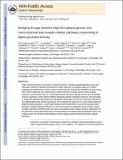Bridging the gap between high-throughput genetic and transcriptional data reveals cellular pathways responding to alpha-synuclein toxicity
Author(s)
Yeger-Lotem, Esti; Riva, Laura; Su, Linhui Julie; Gitler, Aaron D.; Cashikar, Anil G.; King, Oliver D.; Auluck, Pavan K.; Geddie, Melissa L.; Valastyan, Julie Suzanne; Lindquist, Susan; Fraenkel, Ernest; Karger, David R; ... Show more Show less
Download79DC2608d01.pdf (2.586Mb)
PUBLISHER_POLICY
Publisher Policy
Article is made available in accordance with the publisher's policy and may be subject to US copyright law. Please refer to the publisher's site for terms of use.
Alternative title
Bridging high-throughput genetic and transcriptional data reveals cellular responses to alpha-synuclein toxicity
Terms of use
Metadata
Show full item recordAbstract
Cells respond to stimuli by changes in various processes, including signaling pathways and gene
expression. Efforts to identify components of these responses increasingly depend on mRNA
profiling and genetic library screens, yet the functional roles of the genes identified by these assays
often remain enigmatic. By comparing the results of these two assays across various cellular
responses, we found that they are consistently distinct. Moreover, genetic screens tend to identify
response regulators, while mRNA profiling frequently detects metabolic responses. We developed
an integrative approach that bridges the gap between these data using known molecular interactions,
thus highlighting major response pathways. We harnessed this approach to reveal cellular pathways
related to alpha-synuclein, a small lipid-binding protein implicated in several neurodegenerative
disorders including Parkinson disease. For this we screened an established yeast model for alphasynuclein
toxicity to identify genes that when overexpressed alter cellular survival. Application of
our algorithm to these data and data from mRNA profiling provided functional explanations for many
of these genes and revealed novel relations between alpha-synuclein toxicity and basic cellular
pathways.
Date issued
2009-02Department
Massachusetts Institute of Technology. Computer Science and Artificial Intelligence Laboratory; Massachusetts Institute of Technology. Department of Biological Engineering; Massachusetts Institute of Technology. Department of Biology; Massachusetts Institute of Technology. Department of Electrical Engineering and Computer Science; Whitehead Institute for Biomedical ResearchJournal
Nature Genetics
Publisher
Nature Publishing Group
Citation
Yeger-Lotem, Esti et al. “Bridging high-throughput genetic and transcriptional data reveals cellular responses to alpha-synuclein toxicity.” Nat Genet 41.3 (2009): 316-323.
Version: Author's final manuscript
ISSN
1061-4036